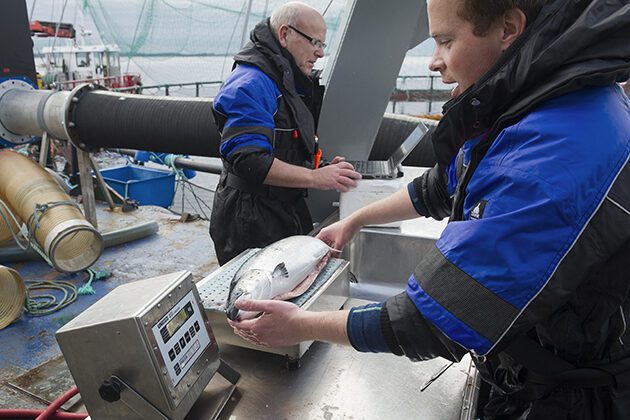Investigating Urea for Enhanced Welfare in Farmed Salmon

In the project titled 'Urea in Farmed Salmon Feed for Enhanced Fish Welfare,' our aim is to explore the potential benefits of incorporating urea as an additive into farmed salmon feed.
Start
01. Aug 2023
End
31. Mar 2025
Funded by
FHF
Cooperation
NMBU
Project Manager(s):
Other Participants:
Vetle Skjold
Lene Sveen
Aleksei Krasnov
Carlo C. Lazado
Gerrit Timmerhaus
Kirsti Hjelde
We are delving into the possibility of this additive reducing wounds, promoting increased mucus production, and facilitating a better seawater tolerance during stressful events.
Norwegian aquaculture confronts significant health challenges, including winter ulcers, wound development, and mechanical injuries from handling and delousing processes.
The 2021 Fish Health Report from the Norwegian Veterinary Institute identifies ulcers with bacterial infections, along with handling-induced wounds, as the primary health concerns within current salmon farming practices. These issues have detrimental effects on fish welfare and contribute to escalated mortality rates. Moreover, these issues may challenge the fish’s seawater tolerance due to stress and ulceration.
Given the gravity of this situation, it becomes imperative to explore strategies that can alleviate these health challenges and improve overall fish welfare. Urea emerges as a potential solution, drawing parallels to its known ability to maintain moisture and elasticity in human skin. Importantly, urea has demonstrated potential health benefits for salmonids as well.
Previous Research on Urea’s Effects and Project Objectives
Past studies by Nofima have examined the effects of urea additives in salmonids feeds, particularly its role as an osmolyte to enhance seawater tolerance and mitigate water loss in salmon muscles during low sea temperatures. The inclusion of urea led to reduced drinking needs, increased muscle water content, improved growth rates, and fewer cases of winter ulcers. Additionally, studies have indicated that incorporating urea into rainbow trout feed can stimulate greater mucus production in both skin and gills.
In this project, our primary goal is to reevaluate and explore the viability of urea additives in addressing ongoing health challenges in seawater-farmed salmon. Specifically, we aim to reduce issues related to winter ulcers, wound development, and mechanical injuries that result from handling and delousing. This project will be conducted in Nofimas R&D licenses at various locations in Norway, allowing us to examine urea’s efficacy under diverse conditions, including varying latitudes with distinct sea temperatures, delousing/handling requirements, and disease scenarios.
Goal
To examine urea’s impact on mucus production, wound development, seawater tolerance, and overall fish welfare in farmed salmon.
Sub goals
- Investigate the influence of urea on gill and skin health, with a specific focus on mucus production. This involves analysing mucus cell density, size, and quantifying neutral and acidic mucus cells.
- Explore the mechanisms behind urea’s effects on the barrier function of skin, gills, and intestines. We will also assess whether a correlation exists between this phenomenon and protection against ulcers, lice, and osmotic imbalances.
- Identify urea’s impact on osmotic, ionic, and metabolic processes in blood, kidneys, gills, and liver. Additionally, we will explore how these processes influence seawater tolerance under stressors such as salinity changes, handling, and diseases.
- Ensure that the inclusion of urea in feed does not adversely affect quality or sensory attributes within specified retention periods.
This is what we aim to do
- Nofima will conduct a range of analyses to explore urea’s impact on skin, gills, and intestinal barrier functions.
- Leveraging AI technology, we will carry out objective histological evaluations on a substantial number of samples.
- Our study benefits from the comparison of field observations, encompassing morphology, welfare scores, lice counts, etc., with production data. This comprehensive approach involves blood chemistry assessments, gene expression studies, and tissue analyses.
- Through a combination of applied and basic research, we aspire to provide meaningful solutions to challenges faced by the aquaculture industry.
Research facilities